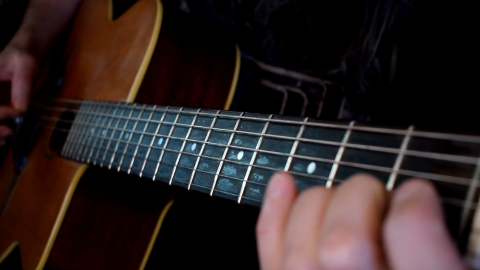Alright so we are back for part 2 of my improvisation series. Now, if you missed last week, you’re going to want to get started here.
It’s true that you could simply start with what I’m going to show you today but, if you do, know that everyone who started with step 1 will be moving exponentially faster than you towards the final goal.
Okay, let’s get right into it. This week’s exercise is simple. You’re going to spend time every day doing nothing but improvising on an open position E-minor scale with absolutely no accompaniment. But this won’t be noodling around. You’ll actually be playing a solo improvisation. You can achieve this without knowing anything other than the E-minor scale and using the open low E as a drone. In other words, you’ll be accompanying yourself by simply hitting the low E as you see fit.
The drone note achieves a number of things, but there are only two points that are important for us to go over now.
The first is that, by hitting the drone E and letting it ring out over most of what you play, you will constantly be hearing each note of the scale as it melodically and harmonically relates to the root of the key. Practice doing this enough and you’ll begin to get a musical sense for the scale that will make finding the exact note you want much, much easier. See this as an extension of last week’s exercise. It actually goes quite a bit further than that, in terms of connecting your ear to the guitar, but that’s all you need to think about right now.
The other point is that, by adding the drone E to improvising with the scale, you can actually start improvising solo music that sounds good right away. This is a very simple and age old method of improvisation. Plus, it’s incredibly fun to do.
I put together a tab for the scale and a video of me improvising in this method to help you get an idea of how this works. The link to the video is below and the link to the tab is in the video description. I highly recommend checking out the video just to get an idea of what this method is about.
Bear in mind that I simply turned on the camera and recorded a single take of this. It’s not rehearsed or prepared in any way. I simply followed the sound of the scale to create something simple and pleasing sounding off the top of my head.
As you practice this, you will get a sense of the scale and how each note relates to the others. It’s better to let your subconscious take over and just follow the sound. It will likely take a bit of practice to get to the point where you can even do what I’m doing in the video, but you will be surprised at how quickly it starts to sound good.
Find the video here: https://youtu.be/uk-6bdQnfSQ
Don’t try to do anything fancy or use any special techniques. Keep it simple and just follow the sound. Don’t think in terms of things you already know but simply think in terms of what note will sound good after the previous one. Try to let it come out as naturally as possible. This is not about impressing anyone. The goal here is to take these simple limitations and produce pleasant sounds out of them.
If you don’t already know the scale, take some time to memorize it so you don’t have to think about it.
Then simply follow your ear.
Spend a little bit of time on this each day and I’ll have something more interesting for you next week.
Have fun!
Dan Mumm
Looking for something new to practice? Check out my massive catalog of guitar related products, covering everything from Metal versions of Classical pieces, Neo-Classical Shred technique, Sweep Picking, and more! See what’s on sale today at the link below:
